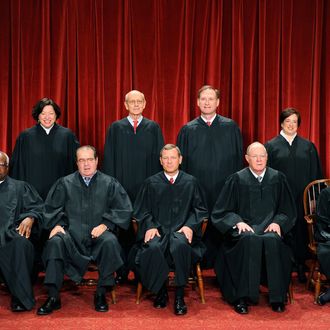
During Thursday night’s Democratic candidates’ debate in New Hampshire, Bernie Sanders made an interesting admission when asked how he would prioritize his agenda if elected president:
>[Y]ou’re not going to accomplish what has to be done for working families and the middle class unless there is campaign-finance reform.
So long as big-money interests control the United States Congress, it is gonna be very hard to do what has to be done for working families. So let me be very clear. No nominee of mine, if I’m elected president, to the United States Supreme Court will get that nomination unless he or she is loud and clear and says they will vote to overturn Citizens United.
Aside from the problematic nature of an explicit litmus test for Supreme Court nominees (which conservatives have danced around for years in their efforts to get a Court that will overturn Roe v. Wade), Sanders is implicitly saying the big bold “political revolution” he wants to lead will bring millions of people to march on Washington to … wait for a conservative SCOTUS Justice to retire or die. Only then can Sanders begin vetting candidates for the opening, make an appointment, fight for confirmation against a certain Republican filibuster, and then hope a case comes up soon enough to create an opportunity to reconsider Citizens United v. FEC in order to get the revolution actually rolling. This sounds, in fact, like the work of an entire presidential term.
But Sanders is right: There’s a lot at stake for both parties in the future shape of a currently closely divided Court. Of the four justices over the age of 75, two are considered liberal (Ginsburg and Breyer), one is a staunch conservative (Scalia), and one (Kennedy) is the “swing vote,” considered conservative on many issues involving corporate power but famously liberal on same-sex marriage (he is a highly ambivalent figure on one hot-button issue, abortion). So the next president, particularly if she or he has a second term, could have appointments that entirely move the Court in one direction or its opposite. The issues the Court could resolve in the next decade in one way or another are immense in their significance: everything from the scope of executive powers, to federal regulation of corporations, to voting rights, to surveillance, to “religious freedom,” to racial and gender preferences, to criminal-justice reform. And yes, a Democratic president could produce a Court willing to reconsider the whole chain of decisions leading up to and including Citizens United that have made political donations a form of constitutionally protected “speech,” while a Republican president could all but guarantee a reversal or major revision of Roe. Depending on the president and the appointments available, a Republican could even push for a revolutionary return to the pre-FDR Lochner era of jurisprudence in which social programs or federal interference with business prerogatives were frequently held to be unconstitutional.
One reason it’s hard to plot the judicial future is that partisan polarization is rapidly bringing to an end the old tradition of senatorial deference to the president’s picks for the Court (within reasonable limits). So if the Senate is controlled by the opposing party, SCOTUS nominees will have to be negotiated carefully, and even if the president’s party controls the Senate, filibusters can and will be deployed routinely. This means, for example, that if a President Bernie Sanders does appoint a justice who is publicly committed to overturning Citizens United, he’d better hope a 60-vote Democratic Senate gets elected with him (virtually an impossibility, of course). As it happens, Senate Republicans are currently toying with the idea of building on Harry Reid’s abolition of filibusters for lower-court (and Executive-branch) appointments to ban SCOTUS filibusters, too, but that may well depend on how confident they are of victory in November.
Important as SCOTUS appointments would be to Sanders or Clinton or to the large field of anti-choicers in the GOP presidential field, this has never become a significant issue in a presidential general election. Could this be the year that changes? It could if either Sanders (who, again, views campaign-finance reform as a condition precedent for much of his agenda) or Ted Cruz (the self-proclaimed “constitutional conservative”) wins a nomination. It’s also possible a Hillary Clinton presidential candidacy would make defense of Roe v. Wade or reestablishment of voting rights a public priority. More likely, SCOTUS will continue to be an underground issue of immense importance to constituency and interest groups but only discussed by the candidates indirectly or via dog whistles to the initiated. With so many key issues before the Court, at the same time that so many are gridlocked in Congress, SCOTUS appointments deserve to be treated as something much bigger than a personnel or process issue.






























